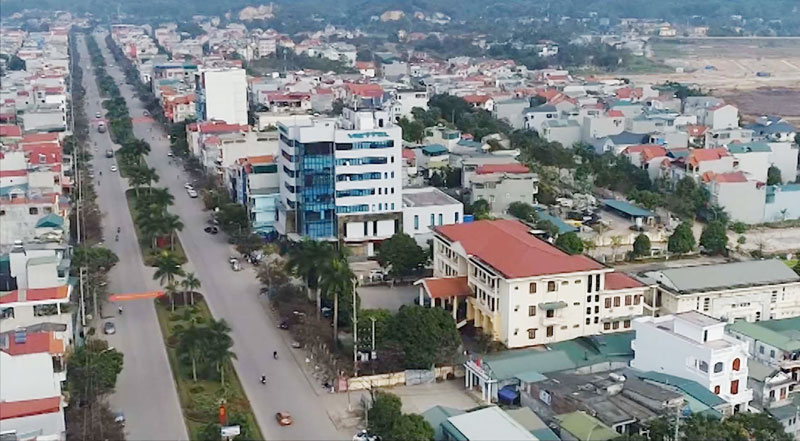
(HBO) - Over the past years, Hoa Binh province has paid special attention to developing urban infrastructure of Hoa Binh city. The face of the city has changed gradually in a cleaner, more spacious and civilised manner.
 A corner of today’s Hoa Binh city.
A corner of today’s Hoa Binh city.
In the 2015-2020
period, the city focused on establishing, supplementing and adjusting urban
planning and detail planning; coordinated and announced a decision approving a
project to adjust Hoa Binh city’s general planning until 2035; set up and
assessed 17 urban planning projects in accordance with the law, made detail
planning at the 1/500 scale for 17 projects with a total area of 922ha, or
20.96 percent; and made the 1/2000 scale planning for four subdivisions, with a
combined area of 2,092ha out of 4,400ha, or 47.5 percent. Up to 100 percent of
new urban areas’ land was zoned out under the 1/2000 scale subdivision
planning.
In the past five
years, Hoa Binh city granted planning licenses to five projects, made public
approved projects, planted landmarks at the site, and strengthened construction
management. The locality also carried out a policy encouraging the involvement
of sectors in urban environmental sanitation, and basically solved the
gathering of garbage on the roadway, with over 90 percent of daily-life garbage
treated.
Attention was also paid
to the urban embellishment, contributing to improving the face of the city,
while the electricity and water systems were upgraded, better meeting locals’
demand.
Hoa Binh city is holding
many opportunities when expanding its administrative boundaries. In the coming
time, the city will focus on directing and making general adjustment plan of
the city; publicising the planting of landmarks in the field in accordance with
the approved planning.
It pledges to create favorable
conditions to attract investors, especially in the fields of urban
infrastructure, transport, electricity, water supply and drainage,
culture-sports, public welfare and in addressing environmental pollution.
Efforts will also be
made to well perform the State management on land and the environment, ensure
traffic safety, and minimise the state of encroaching roadbeds and sidewalks to
use for business activities and market gatherings.
It will strive to
complete all criteria to make it become a tier-II urban city before 2025./.
Hoa Binh province is undergoing a dynamic transformation amid Vietnam’s national digital transition. Building on Poliburo’s Resolution No. 57-NQ/TW on breakthroughs in science, technology, innovation, and national digital transformation, the province has rolled out a wide range of practical action plans. A standout initiative is the "Digital Literacy for All” movement, an effort to ensure that no one is left behind in the digital era.
Hoa Binh province is undergoing a dynamic transformation in the wake of the national digital transformation movement. Building on Resolution No. 57-NQ/TW of the Politburo on breakthroughs in science, technology, innovation, and national digital transformation, the province has implemented a wide range of practical action plans. A standout initiative is the "Digital Literacy for All” movement ambitious effort to ensure that no one is left behind in the digital age.
With a spirit of unity and proactive problem-solving, the Party Committee, the government and the people of Dong Lai Commune (Tan Lac District) have made great strides in implementing the resolutions of the 24th Party Congress of the commune for the 2020 - 2025 term. Focusing on leadership and practical actions, the commune has brought the Party’s resolutions into daily life, creating strong impacts and pushing the local development forward.
Amid the nationwide push for digital transformation, young people in Hoa Binh Province are stepping up as dynamic pioneers, applying technology to enhance Youth Union operations and expand the reach of youth-led initiatives. Through creativity and adaptability, Youth Union organizations at all levels have introduced a series of practical solutions, contributing to modern governance and community development.
In recent years, An Nghia commune, located in Lac Son district, has stepped up administrative reform, focusing on improving the quality and efficiency of its single-window service unit for receiving and processing administrative procedures. These improvements have helped create favourable conditions for local residents and organisations to handle administrative procedures, contributing to the commune’s broader socio-economic development.
The Prime Minister-approved master plan to develop the multi-use value of forests ecosystems through 2030, with a vision to 2050, aims to improve the management and sustainable use of forest resources, create jobs, increase incomes, and improve the living standards of ethnic minorities, people in mountainous and remote areas, forest workers and those living near forests.



 A corner of today’s Hoa Binh city.
A corner of today’s Hoa Binh city.